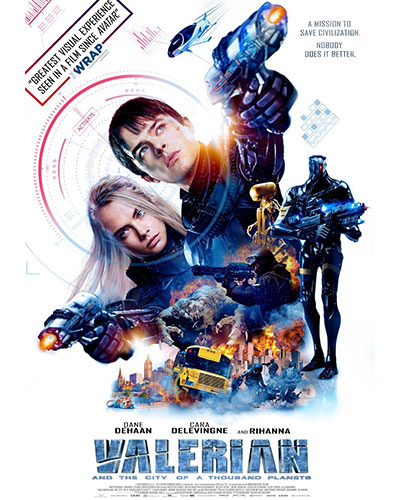What’s to watch on Netflix?
- 13 Apr - 19 Apr, 2024

One can understand – and more importantly appreciate – director Luc Besson’s inspirations. Valerian and the City of a Thousand Planets is a visual spectacle, and even at the expense of being clichéd, is a fine, exhilarating adventure, nearly at par with just about every recent space epic from Star Wars (especially these last two ones, and episodes I to III), Guardians of the Galaxy, Thor Ragnarok and Avatar.
Yes, I may seem like blowing the movie out of proportion, but humour me a little as I explain.
Valerian is an old-school type adventure out of the 80s and 90s; the emphasis is more on popcorn shenanigans than an actual long-winded story (ala Avatar), or deeply exploring alien cultures in equally long-winded chronicles (again, Avatar).
The film opens, with a variation of David Bowie’s Starman – spectacularly, I may add – and the beginning of the space race in the 1970’s. Decades pass, and each brief segment of a cut charts the history of mankind’s venture into space. Different nations come together, the barrier of different languages being rendered inert by a simple handshake. First between the American and the Russians, and then later, between humans and extraterrestrials.
Besson tells a staggering amount of backstory with vivid detail in such a small time. By the credits, we are already in tune and mesmerised by the story.
The story then amps up even more by shifting its attention to a peaceful race of extraterrestrials living in perpetual paradise. These people are called Pearls – their bodies, translucent; their physique, lithe; their movement graceful and swaying. When they pass each other, they offer peaceful salutations – and mean it. The young play in the sand, while the adult mine the sea for pearls (the planet’s main source of cultivation). A portion of their accumulation they give back to the planet so that it may prosper.
Their happiness is short-lived, as the race is almost entirely wiped out by giant spaceships that fall from the sky, obliterating the Pearl’s world.
Valerian, then dips a little when we meet the movie’s leading pair – Dane DeHaan and Cara Delevingne – Valerian and Laureline, a major and a sergeant from Earth.
The couple, who travel as a pair, seem a tad young to be the main characters of an epic space movie; the fact that they are indispensable for the Earth government, also breaks the reality Besson had created so far – it begs one to question: what age were they when they gained such universal notoriety? They hardly look 20.
Despite this dip, Besson keeps ramping up the adventure, plowing through one event – and extraterrestrial race – after another. The movie hardly lets up, its visual effects, motion captured animation, lighting, animation, rendering, editing and production design – the sum of parts constituting to overall grandness.
Regardless of the youngness of his cast, Besson makes their romance credible, and gives both actors their own solo action and drama sequences. Lauraline, especially, is written with a level of sincerity and fondness – almost as if Besson personally favoured her.
But then again, most of Besson’s works often spotlights the film’s leading lady – be it Nikita (Anne Parillaud), Leon the Professional (Natalie Portman), The Fifth Element (Milla Jovovich), The Messenger: The Story of Joan of Arc (again, Jovovich), The Extraordinary Adventures of Adèle Blanc-Sec (Louise Bourgoin), The Lady (Michelle Yeoh playing Burma’s Aung San Suu Kyi) and recently Lucy (Scarlett Johannsson).
Yes, that’s a lot of women in powerhouse roles – and yes, most of them are popcorn adventures.
The unjust negative hype surrounding Valerian seems to forget the director’s personal tilt towards strong women, cutting edge technology and a personal (and instantly identifiable) directorial point of view… unfortunately. •
Valerian is an old-school type adventure out of the 80s and 90s; the emphasis is more on popcorn shenanigans than an actual long-winded story (ala Avatar), or deeply exploring alien cultures in equally long-winded chronicles
COMMENTS